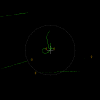zaitcev
En-Route
- Joined
- Sep 30, 2010
- Messages
- 3,257
- Display Name
Display name:
Pete Zaitcev
I started tinkering with a traffic system, which I intend to test in flight eventually. The basic idea is to have 2 inputs: ADS-B and GPS, and 1 output: traffic picture.
Initially, ADS-B is taken from 1090ES received based on RTL-SDR. The first RTL dongle that I bought used the classic Elonics tuner with a gap, but the other one has R820T and works at 1090 MHz. I made a little monopole antenna for it, which works quite well.
I am looking for a cheap UAT receiver, but so far I was unable to repurpose RTL-SDR for it: the data rate is too high for the available sampling rate, apparently. RTL's 2.8 s/s ought to cover ~1 megabit that UAT uses, but in practice it just doesn't work. Most likely I'll have to build a semi-hardware 987 MHz receiver and decoder.
GPS could be anything with NMEA, I'm using an AV8OR that I have available.
For the output, I'm going to provide a WiFi access point (by way of hostapd -- I did it before), DHCP service, and a webserver that only serves one page with the situation picture. Should work with any tablet for a display, even crippled devices like Amazon Kindle or any smartphone.
The software is here:
https://github.com/zaitcev/glie
Initially, ADS-B is taken from 1090ES received based on RTL-SDR. The first RTL dongle that I bought used the classic Elonics tuner with a gap, but the other one has R820T and works at 1090 MHz. I made a little monopole antenna for it, which works quite well.
I am looking for a cheap UAT receiver, but so far I was unable to repurpose RTL-SDR for it: the data rate is too high for the available sampling rate, apparently. RTL's 2.8 s/s ought to cover ~1 megabit that UAT uses, but in practice it just doesn't work. Most likely I'll have to build a semi-hardware 987 MHz receiver and decoder.
GPS could be anything with NMEA, I'm using an AV8OR that I have available.
For the output, I'm going to provide a WiFi access point (by way of hostapd -- I did it before), DHCP service, and a webserver that only serves one page with the situation picture. Should work with any tablet for a display, even crippled devices like Amazon Kindle or any smartphone.
The software is here:
https://github.com/zaitcev/glie


